(完整版)译林版小学英语3B各单元知识点归类及期末复习资料
新译林3B知识点汇总
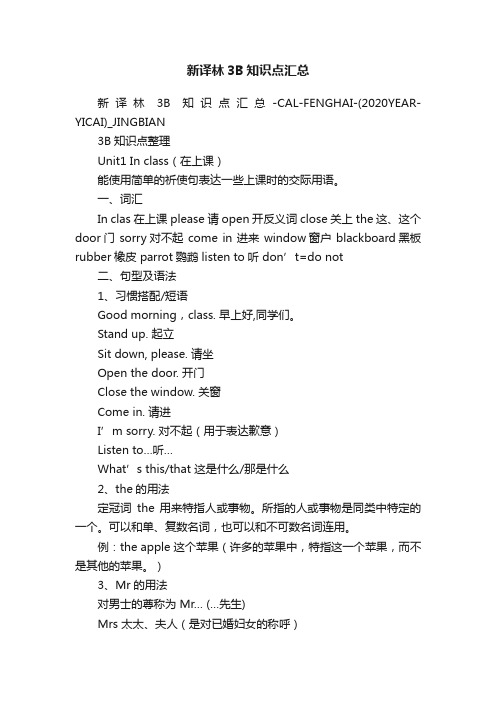
新译林3B知识点汇总新译林3B知识点汇总-CAL-FENGHAI-(2020YEAR-YICAI)_JINGBIAN3B知识点整理Unit1 In class(在上课)能使用简单的祈使句表达一些上课时的交际用语。
一、词汇In clas在上课 please请 open开反义词 close关上 the这、这个door门 sorry对不起 come in 进来 window窗户 blackboard黑板rubber橡皮 parrot鹦鹉 listen to听don’t=do not二、句型及语法1、习惯搭配/短语Good morning,class. 早上好,同学们。
Stand up. 起立Sit down, please. 请坐Open the door. 开门Close the window. 关窗Come in. 请进I’m sorry. 对不起(用于表达歉意)Listen to…听…What’s this/that 这是什么/那是什么2、the的用法定冠词the 用来特指人或事物。
所指的人或事物是同类中特定的一个。
可以和单、复数名词,也可以和不可数名词连用。
例:the apple 这个苹果(许多的苹果中,特指这一个苹果,而不是其他的苹果。
)3、Mr的用法对男士的尊称为Mr… (…先生)Mrs 太太、夫人(是对已婚妇女的称呼)Miss 小姐(是对未婚妇女的称呼)4、询问“这/那是什么”的句型及其答句What’s this/thatIt’s …5、Don’t引导的祈使句结构:① Don’t + 动词原形 + 其他。
② Don’t be + 其他。
Don’t listen to the parrot.不要听鹦鹉的。
Don’t be late. 不要迟到。
6、“某人有某物”的表达主语+ have/has … have/has 的意思是“拥有”。
主语是三单的时候要用has。
例:Bob has two big , big books. 鲍勃有2本大大的书。
译林版)3B U1-8各单元知识点
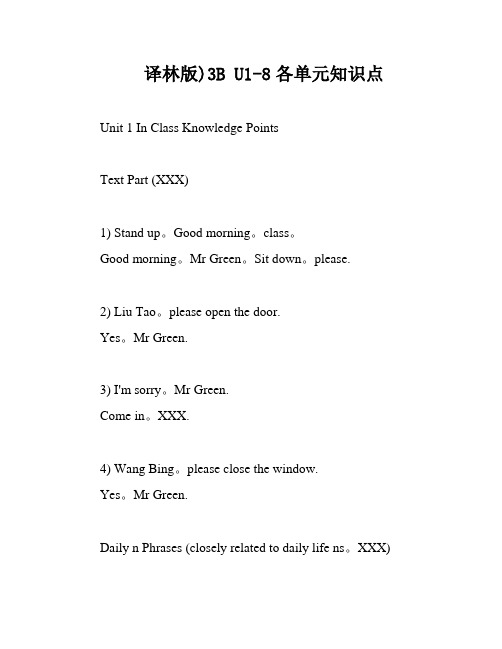
译林版)3B U1-8各单元知识点Unit 1 In Class Knowledge PointsText Part (XXX)1) Stand up。
Good morning。
class。
Good morning。
Mr Green。
Sit down。
please.2) Liu Tao。
please open the door.Yes。
Mr Green.3) I'm sorry。
Mr Green.Come in。
XXX.4) Wang Bing。
please close the window.Yes。
Mr Green.Daily n Phrases (closely related to daily life ns。
XXX)1.XXX.2.Stand up。
3.XXX。
e in。
please。
5.Close the window。
please。
6.Look at the blackboard。
please。
7.Yes。
/All right。
/OK。
/Sure.Words and PhrasesA。
Able to understand。
speak。
read。
and write proficiently1.open2.the3.door4.close5.window6.bookB。
Able to understand。
speak。
and read1.in class2.Stand up。
3.Mr4.sit down5.please6.sorry7.XXX8.blackboard9.XXX10.don't=do not11.listen to12.parrotC。
Able to understand。
speak。
and read the following phrases and ns1.in class2.good morning3.stand up4.sit down5.open the door6.XXX7.close the window8.look at the blackboard9.Don't listen to the parrot.6) Liu Tao。
新版译林小学英语3B期末复习知识点归纳

新版译林小学英语3B期末复习知识点归纳In class 在上课在上课时,我们可以使用简单的祈使句表达一些交际用语。
以下是一些常见的词汇和句型:一、词汇please 请open 开反义词 close 关上the 这、这个door 门sorry 对不起___ 进来window 窗户blackboard 黑板rubber 橡皮parrot 鹦鹉___ 听don’t = do not 不要二、句型及语法1、惯搭配/短语在上课时,我们需要使用一些固定的搭配和短语,例如:Good morning。
class。
早上好,同学们。
Stand up。
起立。
Sit down。
please。
请坐。
___ 开门。
Open/close the book。
打开/合上书。
Close the window。
关窗。
___。
看黑板。
Come in。
请进。
Off we go。
我们一起走。
I’m sorry。
对不起(用于表达歉意)。
___… 听…例如:___…(听我/他/刘涛/鹦鹉/老师…)2、___的用法the”是定冠词,用来特指人或事物。
所指的人或事物是同类中特定的一个。
可以和单、复数名词,也可以和不可数名词连用。
例如:the apple 这个苹果(许多的苹果中,特指这一个苹果,而不是其他的苹果。
)3、Mr的用法对男士的尊称为Mr…(…先生);Mrs太太、夫人(是对已婚妇女的称呼);___小姐(是对未婚妇女的称呼)。
4、询问“这/那是什么?”的句型及其答句___?” “It’s a/an…”例如:“What’s this?” “It’s a book.”5、Don’t引导的祈使句Don’t”引导的祈使句用于表达否定的命令或建议。
结构为:①Don’t +动词原形+其他。
例如:Don’t listen to the parrot。
不要听鹦鹉的。
②Don’t be +其他。
例如:Don’t be late。
不要迟到。
6、“某人有某物”的表达主语+ have/has…”用于表达某人拥有某物。
译林版小学英语3B各单元知识点归类及期末复习资料
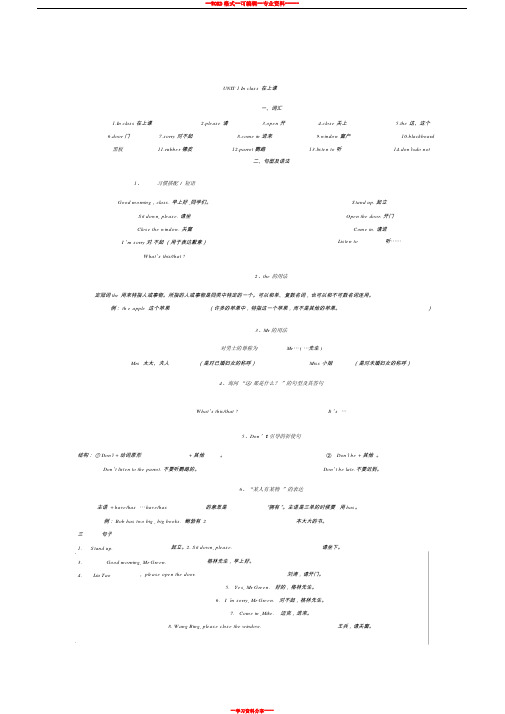
UNIT 1 In class在上课一、词汇1.In class 在上课2.please 请3.open 开4.close 关上5.the 这、这个6.door 门7.sorry 对不起e in 进来9.window 窗户10.blackboard 黑板11.rubber 橡皮12.parrot 鹦鹉13.listen to 听14.don’t=do not二、句型及语法1、习惯搭配/短语Good morning,class. 早上好 ,同学们。
Sit down, please. 请坐Close the window. 关窗I ’ m sorry对.不起(用于表达歉意)What’ s this/that ?Stand up. 起立Open the door. 开门Come in. 请进Listen to听⋯⋯2、the 的用法定冠词 the 用来特指人或事物。
所指的人或事物是同类中特定的一个。
可以和单、复数名词,也可以和不可数名词连用。
例: th e apple 这个苹果(许多的苹果中,特指这一个苹果,而不是其他的苹果。
)3、Mr 的用法对男士的尊称为Mr⋯ ( ⋯先生 )Mrs 太太、夫人(是对已婚妇女的称呼)Miss 小姐(是对未婚妇女的称呼)4、询问“这/ 那是什么?”的句型及其答句What’ s this/that ?It ’ s ⋯5、Don’t引导的祈使句结构:① Don’t + 动词原形+ 其他。
Don’ t listen to the parrot. 不要听鹦鹉的。
②Don’t be + 其他。
Don’ t be late.不要迟到。
6、“某人有某物”的表达主语 + have/has ⋯ have/has的意思是“拥有”。
主语是三单的时候要用 has。
例: Bob has two big , big books. 鲍勃有 2本大大的书。
三句子1.Stand up.起立。
2. Sit down, please.请坐下。
译林版小学英语3B各单元知识点归类及期末复习资料

译林版小学英语3B各单元知识点归类及期末复习资料Unit 1 In ClassIn this unit。
we learn how to use simple imperative sentences to express some communicative phrases in class.Vocabulary:1.In class2.Please3.Open4.Close5.The6.Door7.Sorrye in9.Window10.Blackboard11.Rubber12.Parrot13.Listen to14.Don'tSentence structures and grammar:mon ns and phrases: Good morning。
class.Stand up.Sit down。
please.Open the door.Close the window.Come in.I'm sorry.Listen to。
What's this/that?2.The usage of "the":The" is used to refer to a specific person or thing within a group of the same kind。
It can be used with singular。
plural。
and uncountable nouns.3.The usage of "Mr":Mr" is a title of respect for men.4.Asking "What's this/that?" and its answer:What's this/that?It's。
5.Imperative sentences with "don't":Structure:Don't + verb + other.Don't be + other.6.Expressing n:Subject + have/has。
译林版小学英语3B知识点汇总
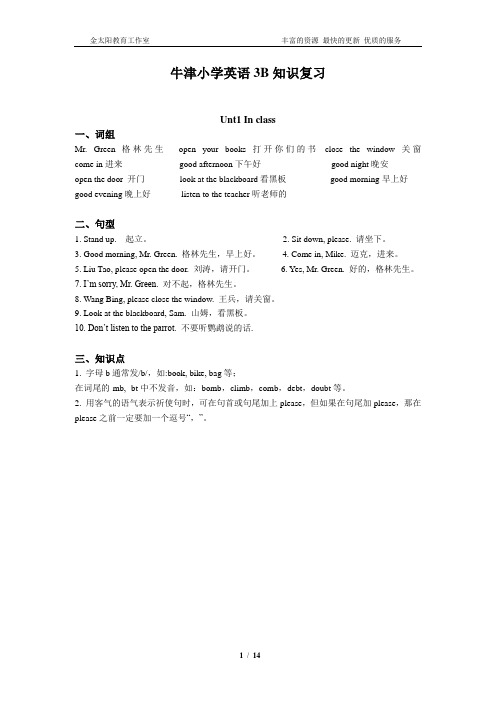
牛津小学英语3B知识复习Unt1 In class一、词组Mr. Green 格林先生open your books 打开你们的书close the window 关窗come in进来good afternoon下午好good night晚安open the door 开门look at the blackboard看黑板good morning早上好good evening晚上好listen to the teacher听老师的二、句型1. Stand up. 起立。
2. Sit down, please. 请坐下。
3. Good morning, Mr. Green. 格林先生,早上好。
4. Come in, Mike. 迈克,进来。
5. Liu Tao, please open the door. 刘涛,请开门。
6. Yes, Mr. Green. 好的,格林先生。
7. I’m sorry, Mr. Green. 对不起,格林先生。
8. Wang Bing, please close the window. 王兵,请关窗。
9. Look at the blackboard, Sam. 山姆,看黑板。
10. Don’t listen to the parrot. 不要听鹦鹉说的话.三、知识点1. 字母b通常发/b/,如:book, bike, bag等;在词尾的-mb, -bt中不发音,如:bomb,climb,comb,debt,doubt等。
2. 用客气的语气表示祈使句时,可在句首或句尾加上please,但如果在句尾加please,那在please之前一定要加一个逗号“,”。
Unit2 In the library一、单词shout喊;叫eat吃run 跑talk说话sleep 睡觉drink喝here这里your你的English英语milk牛奶二、词组in the library 在图书馆里in the classroom在教室里want to…… 想要做…… don’t= do not不;不要三、句型1.Don’t shout/ eat/ run/ talk/sleep/drink.不要叫/吃东西/跑/ 说话/ 睡觉/ 喝东西。
新译林3B知识点汇总
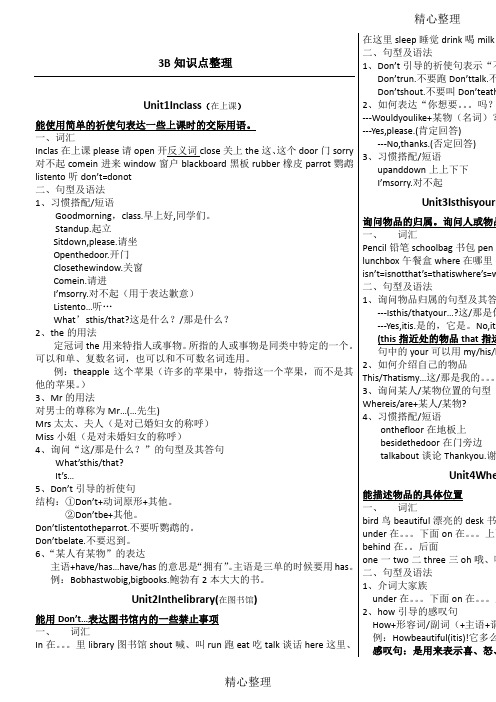
精心整理精心整理3B 知识点整理 Unit1Inclass (在上课)能使用简单的祈使句表达一些上课时的交际用语。
一、词汇Inclas 在上课please 请open 开反义词close 关上the 这、这个door 门sorry对不起comein 进来window 窗户blackboard 黑板rubber 橡皮parrot 鹦鹉listento 听don ’t=donot二、句型及语法1、习惯搭配/短语Goodmorning ,class.早上好,同学们。
Standup.起立Sitdown,please.请坐Openthedoor.开门Closethewindow.关窗Comein.请进I’msorry.对不起(用于表达歉意)Listento …听…What ’sthis/that?这是什么?/那是什么?2、the 的用法定冠词the 用来特指人或事物。
所指的人或事物是同类中特定的一个。
可以和单、复数名词,也可以和不可数名词连用。
例:theapple 这个苹果(许多的苹果中,特指这一个苹果,而不是其他的苹果。
)3、Mr 的用法对男士的尊称为Mr …(…先生)Mrs 太太、夫人(是对已婚妇女的称呼)Miss 小姐(是对未婚妇女的称呼)4、询问“这/那是什么?”的句型及其答句What ’sthis/that?It ’s …5、Don ’t 引导的祈使句结构:①Don ’t+动词原形+其他。
②Don ’tbe+其他。
Don ’tlistentotheparrot.不要听鹦鹉的。
Don ’tbelate.不要迟到。
6、“某人有某物”的表达主语+have/has …have/has 的意思是“拥有”。
主语是三单的时候要用has 。
例:Bobhastwobig,bigbooks.鲍勃有2本大大的书。
Unit2Inthelibrary(在图书馆)能用Don ’t …表达图书馆内的一些禁止事项一、 词汇In 在。
(2021年整理)译林版小学英语3B知识点汇总

(完整版)译林版小学英语3B知识点汇总编辑整理:尊敬的读者朋友们:这里是精品文档编辑中心,本文档内容是由我和我的同事精心编辑整理后发布的,发布之前我们对文中内容进行仔细校对,但是难免会有疏漏的地方,但是任然希望((完整版)译林版小学英语3B 知识点汇总)的内容能够给您的工作和学习带来便利。
同时也真诚的希望收到您的建议和反馈,这将是我们进步的源泉,前进的动力。
本文可编辑可修改,如果觉得对您有帮助请收藏以便随时查阅,最后祝您生活愉快业绩进步,以下为(完整版)译林版小学英语3B知识点汇总的全部内容。
(完整版)译林版小学英语3B知识点汇总编辑整理:张嬗雒老师尊敬的读者朋友们:这里是精品文档编辑中心,本文档内容是由我和我的同事精心编辑整理后发布到文库,发布之前我们对文中内容进行仔细校对,但是难免会有疏漏的地方,但是我们任然希望(完整版)译林版小学英语3B知识点汇总这篇文档能够给您的工作和学习带来便利。
同时我们也真诚的希望收到您的建议和反馈到下面的留言区,这将是我们进步的源泉,前进的动力。
本文可编辑可修改,如果觉得对您有帮助请下载收藏以便随时查阅,最后祝您生活愉快业绩进步,以下为 <(完整版)译林版小学英语3B知识点汇总〉这篇文档的全部内容。
译林小学英语3B知识复习Unit1 In class知识点(贴在书本11页)一、单词shout喊;叫 eat吃 run 跑 talk说话 sleep 睡觉drink喝 here这里 your你的 English英语 milk牛奶二、词组Mr。
Green 格林先生open your books 打开你们的书close the window 关窗come in进来 good afternoon下午好 good night晚安open the door 开门 look at the blackboard看黑板 good morning早上好good evening晚上好 listen to the teacher听老师的三、句型1. Stand up. 起立. 2。
- 1、下载文档前请自行甄别文档内容的完整性,平台不提供额外的编辑、内容补充、找答案等附加服务。
- 2、"仅部分预览"的文档,不可在线预览部分如存在完整性等问题,可反馈申请退款(可完整预览的文档不适用该条件!)。
- 3、如文档侵犯您的权益,请联系客服反馈,我们会尽快为您处理(人工客服工作时间:9:00-18:30)。
UNIT 1 In class在上课一、词汇1.In class在上课2.please请3.open开4.close关上5.the这、这个6.door门7.sorry对不起e in 进来9.window窗户10.blackboard 黑板11.rubber橡皮12.parrot鹦鹉13.listen to听14.don’t=do not 二、句型及语法1、习惯搭配/短语Good morning,class. 早上好,同学们。
Stand up. 起立Sit down, please. 请坐Open the door. 开门Close the window. 关窗Come in. 请进I’m sorry. 对不起(用于表达歉意)Listen to… 听…What’s this/that ?2、the的用法定冠词the 用来特指人或事物。
所指的人或事物是同类中特定的一个。
可以和单、复数名词,也可以和不可数名词连用。
例:th e apple 这个苹果(许多的苹果中,特指这一个苹果,而不是其他的苹果。
)3、Mr的用法对男士的尊称为Mr… (…先生)Mrs 太太、夫人(是对已婚妇女的称呼)Miss 小姐(是对未婚妇女的称呼)4、询问“这/那是什么?”的句型及其答句What’s this/that ?It’s …5、Don’t引导的祈使句结构:① Don’t + 动词原形+ 其他。
② Don’t be + 其他。
Don’t listen to the parro t.不要听鹦鹉的。
Don’t be late. 不要迟到。
6、“某人有某物”的表达主语+ have/has … have/has的意思是“拥有” 。
主语是三单的时候要用has。
例:Bob has two big , big books. 鲍勃有2本大大的书。
三句子1. Stand up. 起立。
2. Sit down, please.请坐下。
3. Good morning, Mr Green.格林先生,早上好。
4. Liu Tao,please open the door.刘涛,请开门。
5. Yes, Mr Green.好的,格林先生。
6. I’m sorry, Mr Green.对不起,格林先生。
7. Come in ,Mike.迈克,进来。
8. Wang Bing, please close the window.王兵,请关窗。
9. Look at the blackboard, Sam.萨姆,看黑板。
10. What’s this?这是什么?11. It’s a rubber.它是一块橡皮。
12. Don’t listen to the parro t.不要听鹦鹉说话.13. open your book. 打开你的书UNIT 2 In the library在图书馆能用Don’t… 表达图书馆内的一些禁止事项一、词汇1.In 在...里2.library图书馆3.shout喊、叫4.run跑5.eat吃6.talk谈话7.here这里、在这里8.sleep睡觉9.drink喝k牛奶11.shh嘘12.your你的二、句型及语法1、Don’t引导的祈使句表示“不要......”Don’t run. 不要跑Don’t talk. 不要说话Don’t sleep. 不要睡觉Don’t shout. 不要叫Don’t eat here. 不要在这里吃2、如何表达“你想要...吗?”的句型及其答句---Would you like + 某物(名词)?---Yes, please. (肯定回答)---No, thanks. (否定回答)3、习惯搭配/短语up and down 上上下下I’m sorry. 对不起Unit21.in the library 在图书馆里2.Shh! Don’t shout, Liu Tao.嘘!不要喊,刘涛。
3.Would you like a sweet, Yang Ling?你想要颗糖吗,杨林?4.Don’t eat here.不要在这里吃。
5.Don’t talk.不要说话。
6.Don’t sleep.不要睡。
7.Don’t eat my cake.不要吃我的蛋糕。
8.Don’t drink my milk.不要喝我的牛奶。
9.my English book我的英语书10.Is this your book?这是你的书吗?11.up and down上下UNIT 3 Is this your pencil?这是你的铅笔吗?询问物品的归属。
询问人或物品的位置一、词汇1.Pencil铅笔2.schoolbag书包3.pen钢笔4.crayon蜡笔5.ruler尺子6.pencilcase铅笔盒7.lunch box午餐盒8.where在哪里9.over there在那里10.isn’t=is not 11.that’s=that is 12.where’s=where is二、句型及语法1、询问物品归属的句型及其答句---Is this/that your …? 这/那是你的...吗?---Yes, it is. 是的,它是。
No, it isn’t. 不,它不是。
(this 指近处的物品that 指远处的物品)句中的your 可以用my / his / her / their 等替换2、如何介绍自己的物品This /That is my … 这/那是我的...3、询问某人/某物位置的句型Where is/are + 某人/ 某物?4、习惯搭配/短语on the floor 在地板上beside the door 在门旁边talk about 谈论Thank you. 谢谢你。
Unit31.This isn’t my pencil. 这不是我的铅笔。
2.Is this your pencil?这是你的铅笔吗?3.No, i t isn’t.不,它不是。
4.That’s my pencil.那是我的铅笔。
5.Is that a pencil?那是一支铅笔吗?6.Yes, it is. It’s a pencil.是的,它是。
它是一支铅笔。
7.my lunch box 我的午餐盒8.It’s over there. 它在那边。
9.What is it? 它是什么?10.This is for you. Thank you. 这是给你的,谢谢你。
UNIT 4 Where’s the bird?鸟在哪里?能描述物品的具体位置一、词汇1.bird鸟2.beautiful漂亮的3.desk书桌4.chair椅子5.tree树6.guess猜7.under在...下面8.on在...上面9.in在...里面10.behind在...后面11.one一12.two二13.three三14.oh哦、啊15.wow 哇、呀二、句型及语法1、介词大家族under在...下面on在...上面in在...里面behind在...后面2、how 引导的感叹句How + 形容词/副词(+主语+谓语)!例:How beautiful ( it is )! 它多么漂亮啊!感叹句:是用来表示喜、怒、哀、乐等情绪,句末用感叹号“!”补充:what 引导的感叹句结构:What +(a/an )+ 形容词+ 名词+ 主语+ 谓语!例:What a good girl she is ! 她是一个多好的女孩啊!3、由is 引导的一般疑问句及其答句--- Is it … ? 它是...吗?---Yes, it is. 是的,它是。
No, it isn’t. 不,它不是。
例:---Is it in your pencil case?它在你的铅笔盒里吗?---Yes, it is. 是的,它在。
注:该句型是由肯定句型It is …… 转化而成的。
将be动词调到句的前面,大写了首写字母并将句尾的句号变为问号。
4、描述物品具体位置的句型主语+ be动词+ 介词短语. ......在......例:It’s behind the door. 它在门后面。
The bird is under your desk. 鸟在你的书桌下面。
5、习惯搭配/短语under your desk 在你的书桌下面behind the door 在门后面on your chair 在你的椅子上面in my desk 在我的书桌里面in the tree 在树上here you are 给你。
Unit41. How beautiful 真漂亮!2. Where’s the bird?小鸟在哪儿?3. It’s under your desk.它在你的课桌下。
4. behind the door 在门后5. It’s not here. Where is it? 它不在这儿。
它在哪里?6. It’s in the tree now.现在它在树上。
7. A bird is in the tree. 一只鸟在树上。
8. on your chair 在你的椅子上9. in my desk 在我的课桌里10. Where’s my pencil? Guess.猜猜我的铅笔在哪里?11. Is it in your schoolbag? 他在你的书包里吗?10. Where’s Bobby? 波比在哪里?11. Where is he? 他在哪里?12. He’s behind the door.他在门后。
13. It’s not Bobby.它不是波比。
Unit 5 How old are you?一、单词1. lovely 可爱的2. right 对的;正确的3. out 出局4. want 想要;想5. four 四6. five 五7. six 六8. seven 七9. eight 八10. nine 九11. ten 十◆补充:12. Mary 玛莉(人名)13. ground 地面14. time 时间15. but 但是16. you’re = you are 你是17. late 迟到18. again 再一次19. panda 熊猫20. dog 狗21. welcome 欢迎22. museum 博物馆二、词组1. how old 几岁2. a toy car 一辆玩具小汽车3. what about = how about …怎么样?◆补充:4. Toy Museum 玩具博物馆5. four pens 四支钢笔6. want to 想要(做…)7. turn round 转圈8. fall to 落到、倒在9. time for time 上课时间到了10. be late for class 上课迟到三、句子1. How lovely! 多么可爱呀!(这是由how引起的感叹句。
